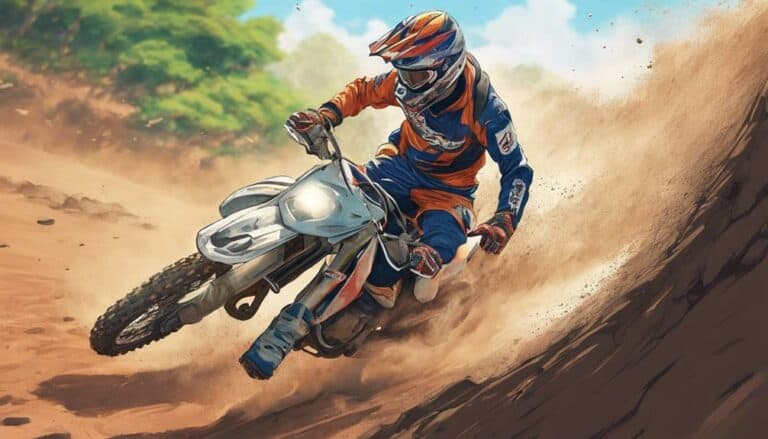When you're out on the trails and the need to downshift on your dirt bike arises, remember, mastering this skill is key to a controlled and efficient ride.
The way you handle the gears can make a significant difference in your overall performance and experience on the dirt.
So, why not explore some essential tips and techniques that can help you navigate those downshifts with finesse and confidence?
Key Takeaways
- Downshift gradually for control and stability on off-road terrain.
- Utilize clutch and engine braking for smooth gear changes and deceleration.
- Avoid common mistakes like abrupt downshifting and multiple gear changes.
- Practice smooth clutch control and gear matching in a controlled environment for improvement.
Importance of Downshifting Correctly
Mastering the art of shifting correctly on a dirt bike is essential for maintaining control and stability in challenging off-road conditions. When you're maneuvering rough terrain, the ability to shift effectively can make all the difference in your riding experience. By shifting on your dirt bike, you can slow down while keeping your engine in the best RPM range, ensuring smooth deceleration without risking losing traction. Proper shifting also helps prevent the rear tire from locking up, giving you better control over your bike on uneven surfaces.
Without mastering the technique of shifting on a dirt bike, you run the risk of straining your engine, potentially stalling, and facing difficulties in handling the bike in demanding off-road environments. To truly liberate your riding potential, understanding the importance of shifting correctly is important. It's not just about slowing down; it's about harnessing the power of your dirt bike's engine to conquer any terrain with confidence and finesse.
Understanding Gear Shifting on Dirt Bike
To ride a dirt bike effectively, understanding how to shift gears is essential for maintaining control and stability in various off-road conditions. Here are some key points to keep in mind when it comes to gear shifting on your dirt bike:
- Match Gear with Speed: Make sure that you're in the appropriate gear for your speed to maintain control and stability while riding your bike.
- Utilize the Clutch: When downshifting, use the clutch to smoothly switch to a lower gear and prevent stalling, especially when slowing down.
- Gradual Downshifting: Downshift gradually as you decelerate to avoid putting unnecessary strain on the engine, leading to a smoother and more controlled ride.
- Shift to First Gear: Always remember to downshift to first gear before coming to a complete stop on your dirt bike. This guarantees a safe and efficient start when you're ready to accelerate again.
Understanding these gear shifting techniques won't only enhance your riding experience but also help in optimizing your bike's performance while keeping you safe on the trails.
Techniques for Smooth Downshifting
When downshifting on a dirt bike, make sure to blip the clutch to synchronize engine speed with the lower gear, facilitating a smoother switch. This technique is essential for maintaining control and preventing the rear wheel from locking up in challenging off-road conditions. Additionally, using engine braking by gradually releasing the throttle while downshifting allows you to decelerate smoothly without solely relying on the brakes, giving you more stability and control.
Remember to keep a light grip on the handlebars to allow the street bike to move freely beneath you, reducing the chances of instability during downshifting. Practice downshifting in a controlled environment to hone your timing and coordination, ensuring seamless gear changes when exploring rough terrain. By listening to the engine sound and feeling the bike's response, you can gauge the perfect moment to downshift, keeping your motorcycle in the best gear for peak performance on dirt trails. Mastering these techniques will enhance your riding experience and boost your confidence on the dirt track.
Common Mistakes to Avoid
To enhance your dirt bike riding skills, you must steer clear of common downshifting mistakes that can compromise your control and safety on challenging terrain. Here are some important errors to avoid when trying to figure out how to downshift effectively:
- Abrupt Downshifting: Avoid downshifting abruptly, as it can cause the rear wheel to lock up on loose surfaces, leading to a loss of control.
- Early Downshifting: Don't downshift too early, as this may result in excessive engine braking, causing a loss of traction and stability.
- Multiple Gears at Once: Avoid downshifting multiple gears at once, as this can destabilize the bike and make it harder to maintain control.
- Throttle Management: Don't downshift while the throttle is still open, as this can unsettle the bike's balance and make it harder to maneuver smoothly.
Practice Tips for Downshifting Success
Enhance your downshifting skills by focusing on smooth clutch control and precise gear matching for best traction on various terrains. When you're out on the dirt, these skills are gonna go a long way in improving your overall riding experience. Practice downshifting in a controlled environment to get comfortable with the gear changes. Remember to use the clutch smoothly to avoid any jerky movements that can throw off your balance. It's essential to match the gear to the appropriate speed, especially on different surfaces, to maintain traction and control.
Check out the table below for some practical tips on how to improve your downshifting technique:
| Practice Tips for Downshifting Success |
|---|
| Practice in a controlled environment |
| Smooth clutch control is key |
| Match gear to appropriate speed |
| Experiment with different techniques |
Conclusion
Now you have the knowledge and techniques to downshift on your dirt bike like a pro. Remember, proper downshifting is vital for maintaining control and preventing engine strain.
Did you know that a study found that 80% of dirt bike accidents are caused by improper gear shifting? So practice these skills, stay safe, and enjoy the thrill of riding with confidence.
Happy trails!

